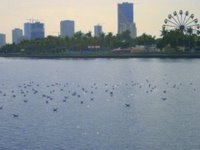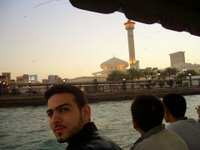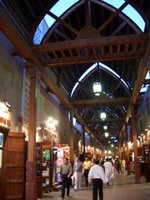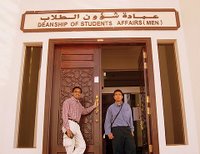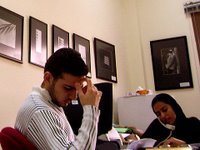TouchdownIt was 3.30 a.m. upon landing at the Dubai International Airport, approximately seven hours since our departure from Kuala Lumpur. With me were four other representatives from the International Islamic University Malaysia, three of them male—Ahmad Aiman, Mohammad Fazli and Yusuf Johari from the Kulliyyah of Engineering—and one female student, Fatimah Yusof, who’s also a Biotechnology major in my Kulliyyah.
We wasted no time in disembarking and moving to get our passports stamped and claim our baggage.
“How long will your visit be, sir?” The female officer at the counter asked me. I told her that I would be staying in the country for four months to study as an exchange student. She gave a confused look at the mention of the duration of my stay as well as the phrase ‘exchange student’, but nonetheless stamped my passport and let me through—“Welcome to UAE”, she said.
Not really sure about the kind of reception waiting, our group headed straight for the main entrance all the while keeping an eye out on signs that might just refer to the five of us in any way. True enough, a green sign bearing the words University of Sharjah greeted us just before we stepped out of the terminal. Our receiver was a man named Bashir, who would be driving us to the University in a van. He didn’t say much, only smiles and a pair of helpful hands for loading our things into the vehicle. The air outside was noticeably chilly though, around 15 to 17 degrees, something I had been told to expect from the winters in UAE. I was just glad to have the olive green jacket on my back even though it was uncomfortably warm in the Emirates Airlines cabin.
Settling inNothing much could be seen along the journey on the highway between Dubai and Sharjah, as it was still dark and not to mention the screens were severely misting up from the low temperature. After about an hour’s drive, we finally reached University City, a wide expanse of land secured around the perimeter with a sturdy palatial fence and lavish gates.

The whole setting was impressive, almost regal with its monumental structures and endless lines of palm trees guarding both sides of the road like dutiful sentries. It took us a few more minutes to navigate the long boulevards within the estate to arrive at the Male Colleges where I and the other three males were to alight. Fatimah was then taken to the other side of the city specified for the women.
Only when I started to unload my things from the back of the van did I notice that Sharjah was in fact
As-Shariqah in Arabic—the difference, I later learned, is due to the variation in the way the letter qaf is pronounced colloquially. That was probably the first of what would later be a series of enlightening pieces of information and knowledge regarding the Arabic language and Emirati culture as the days progressed.
We were received by warm hands at the office of the male dormitories. After a brief exchange of greetings and confirming our names to be as printed on the facsimile they received, the officer assigned two temporary rooms for us—I shared mine with Aiman while Fazli went with Yusuf. Our room was the size of an average bedroom, complete with a kitchen counter, a private bath as well as the locally indispensable air-conditioner for the hot and dry afternoons of the Middle East—perfectly comfortable.
The next morning, we were directed to another office for the male dorms, possibly the main one from the looks of it. This time, two supervisors were receiving us—with wide, enthusiastic smiles and a generous bowl of toffees and chocolates meant to ensure us that we were in fact, at home in this academic kingdom. They assigned us our permanent rooms—this time I was paired with Fazli—at another building, Saad Ibn Abi Waqqas. Though I was hoping for a more diverse room environment with perhaps locals for roommates, it was understandably a practical arrangement for the four of us to be sufficiently close for easy access to one another, especially in our first days in Sharjah. They also gave us instructions on the rest of the items on our itinerary, namely meeting the Dean of Student Affairs and the Chancellor, student ID registration, declaring majors, visa application, and course scheduling, among other things. It was essential for us to make our presence official as soon as possible, so we didn’t waste much time and got down to unpacking and preparing for the official meeting.
The official receptionFor the first time since our arrival, we set foot at the heart of the campus where the Colleges, classrooms and academic offices were located.

A huge square with a tranquil fountain lay at the middle while the connected buildings flank the three sides of the square, forming an angular U-shaped complex. Seagulls as white as the campus structures flew and frolicked all over the place, apparently having a special niche of their own here.
We were first taken to meet Dr. Abdalla Falah El Mneizel, the Dean of Student Affairs (Men) who had a jovial air about him, as well as an easy laugh. He assured us that our stay here would be well-facilitated, especially in terms of registration and that all of us were welcome to seek his assistance anytime.
Unfortunately, we didn’t have the pleasure of an audience with the Chancellor, Dr. Ismail Mohammed Al Bishri due to a previous engagement he had to attend to. Nevertheless, the Assistant to the Chancellor, Dr. Esam El-Din Ibrahim Agamy received us well on his behalf. Our presence at the University of Sharjah campus was thus official, now that we have been received by the University’s figures of authority. It was then time to get down to business as students—registering was next on our list.
The ‘missing’ reportThings took a different turn just as we proceeded to the Student Registration unit. The officer, who oversaw the issuance of course schedules, requested for our medical checkup results, which none of us had—our results were all with the International Students’ Office back in IIUM—save for Yusuf who apparently got to keep his.
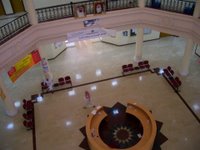
This was certainly unexpected; we’d brought everything else we thought was pertinent to confirm the validity of our presence—the offer letter, passport, student ID card;
definitely pertinent materials. Either the fax from IIU has yet to reach this unit, or checking hard copies of medical examination reports was a routine practice.
Tension was beginning to build up in the office as we attempted to explain how we haven’t got the required documents with us, and show him the rest of the documents we brought. Confusion was unmistakable from the man’s face, and finally he asked for only our passport photos, four pieces to be exact. This too, wasn’t possible at that moment—I for one, had only two pieces left—and in the end we agreed to return to his office after the weekend, since it was already Wednesday and the weekend falls on Thursdays and Fridays in this country.
As grand as the campus was, this University lacked the town-like convenience enjoyed by the IIUM community in Gombak, with the banks and photo studios sorely missing. For that, we had no choice but to venture beyond the campus to get our photos as well as exchange some ringgits for the local dirhams. A trip to Dubai was agreed upon, and a cab was booked for us by the hostel officers who suggested that we head for Dubai City Center, which sounded nice enough. With four months ahead of us, we might as well get acquainted with the renowned Middle Eastern tourism hub—virtually the second capital of the Emirates.
Why wait until later?
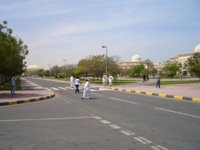 as you made your way around—be they in the ever popular dishdasha or in t-shirt and jeans, accordingly equipped with either tasbeeh beads, or a handsfree mobile device, or an MP3 player in hand. Even though it was just as commonplace back in IIUM, the indiscriminate exchange of greetings evoked a different feeling this time around, one of welcome, peace and unconditional solidarity.
as you made your way around—be they in the ever popular dishdasha or in t-shirt and jeans, accordingly equipped with either tasbeeh beads, or a handsfree mobile device, or an MP3 player in hand. Even though it was just as commonplace back in IIUM, the indiscriminate exchange of greetings evoked a different feeling this time around, one of welcome, peace and unconditional solidarity. with Pakistani blood—alongside others we came across in various circumstances. One thing that struck me amused in particular was the polite, flattering query for your name— “Esmok al kareem? What’s your good name?” That and also the multiple versions of “How do you do?” received at every greeting, which of course almost always prompted me to reply back in no less than a dozen versions of “I’m fine/good/superb/perfect thanks!” It was also common then to receive curious guesses of our origins, with China and/or the Philippines leading most of the attempts. Those who guessed correct on the other hand, would display great interest in the Malaysian politics, economy, infrastructure, and last but not least, the enviable forests, mountains and beaches enjoyed on our side of the globe.
with Pakistani blood—alongside others we came across in various circumstances. One thing that struck me amused in particular was the polite, flattering query for your name— “Esmok al kareem? What’s your good name?” That and also the multiple versions of “How do you do?” received at every greeting, which of course almost always prompted me to reply back in no less than a dozen versions of “I’m fine/good/superb/perfect thanks!” It was also common then to receive curious guesses of our origins, with China and/or the Philippines leading most of the attempts. Those who guessed correct on the other hand, would display great interest in the Malaysian politics, economy, infrastructure, and last but not least, the enviable forests, mountains and beaches enjoyed on our side of the globe.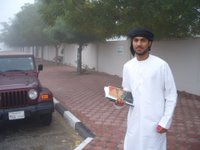 The next surprise came shortly later when Omar invited me over to his room at the Salahuddin block where we stayed for the first night in Sharjah. Without warning, he suggested I move into his place which was pretty much impressive with its private kitchen, bathroom and a nice view—the offer was undeniably exciting. Not only would I be sharing a room with a fellow Health Science student, it also translated as an opportunity to live with a local for four months and enjoy a more wholesome and authentic experience. On a more personal level, the prospect of perfecting my Arabic in such an environment was truly a blessing—and the Emirati value of hospitality, legendary.
The next surprise came shortly later when Omar invited me over to his room at the Salahuddin block where we stayed for the first night in Sharjah. Without warning, he suggested I move into his place which was pretty much impressive with its private kitchen, bathroom and a nice view—the offer was undeniably exciting. Not only would I be sharing a room with a fellow Health Science student, it also translated as an opportunity to live with a local for four months and enjoy a more wholesome and authentic experience. On a more personal level, the prospect of perfecting my Arabic in such an environment was truly a blessing—and the Emirati value of hospitality, legendary.
